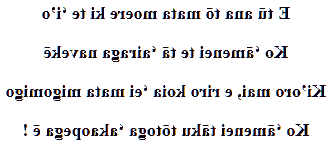Mangarevan love poem
Te ‘I’o
E tū ana tō mata moere ki te ‘i’o
Ko ‘āmenei te tā ‘airaga navekē
Ki’oro mai, e riro koia ‘ei mata migomigo
Ko ‘āmenei tāku tōtoga ‘akaopega ē !


→ French poem ←
Mangarevan language
It gives me big pride to see my little love poem translated into reo magareva, this Polynesian language from the other side of the world.
The Mangarevan (Reo Magareva, Reo 'Iti-poto) takes its name from one of the islands of the Gambier archipelago in French Polynesia, the island of Mangareva which is the main island.
To be academic, in teaching in Polynesia, it is "Reo Magareva" which designates this language. Mangareva with an “n” is the toponym in French of the biggest island, The “ng” actually evokes the nasal sound.
This Eastern Polynesian language of the Marquesan family is one of the languages for which there is an urgent need to worry. It is spoken by about six hundred people, a number which is decreasing because of French continuing to take up more and more space.
While reo tahiti and reo magareva are both Eastern Polynesian languages, it is important to note that the importance of Tahiti and therefore of the Tahitian language weighed heavily in the evolution of Mangarevan.
Gambier Islands
The Gambier archipelago (Magareva = the floating mountain) made up of 14 islands, islets, atolls and sandbanks, with the main islands (Mangareva, Taravai, ‘Aukena,‘ Akamarū and ‘Aga-kau-i-tai), is located in the south-east of French Polynesia almost at the level of the tropic of Capricorn.
Discovered by the English at the very end of the 18th century, the evangelization of the archipelago will begin with the French some thirty years later. This evangelization will require the natives to carry out completely disproportionate constructions which will decimate them. Thus during the passage under French protectorate in 1871 the population of Gambier will have fallen by 3/4.
The Magareva economy, in addition to their tourist aspect, is mainly based on pearl farming, but also fishing, agriculture and breeding (poultry farming).
This archipelago with New Zealand (Ikanāmāui) et Rapa Nui (Vai’ū), is one of the last lands reached during the Pacific explorations of these Austronesian populations, whose original cradle was probably southern China.
The excavations in Magareva, which show human traces dating from the beginning of the 10th century, seem to indicate the date of the arrival of men on these islands. The dating of archaeological traces is quite in tune with what linguistic study and oral tradition can reveal to us.
These same excavations show, that after a real demographic expansion, this one fell, and that perhaps because these islands knew like Easter Island, real climatic, ecological and social disasters. These latter having probably been able to be balanced by the maritime richness of the lagoon.